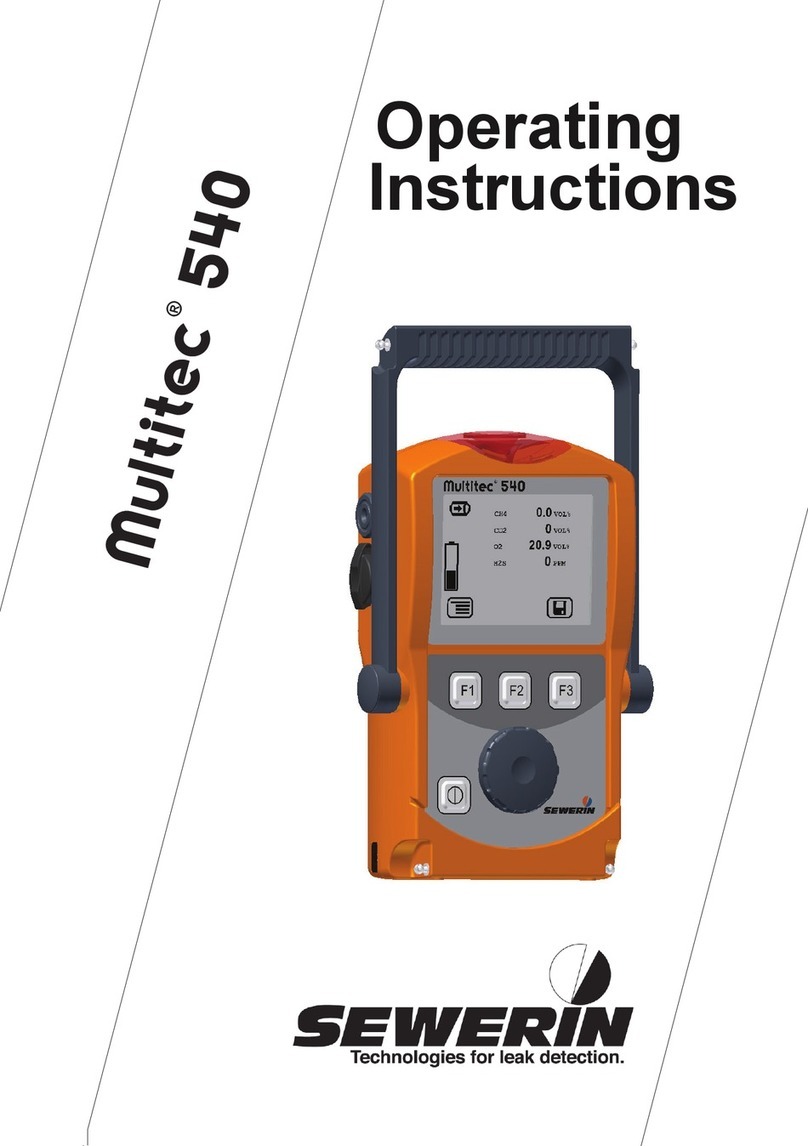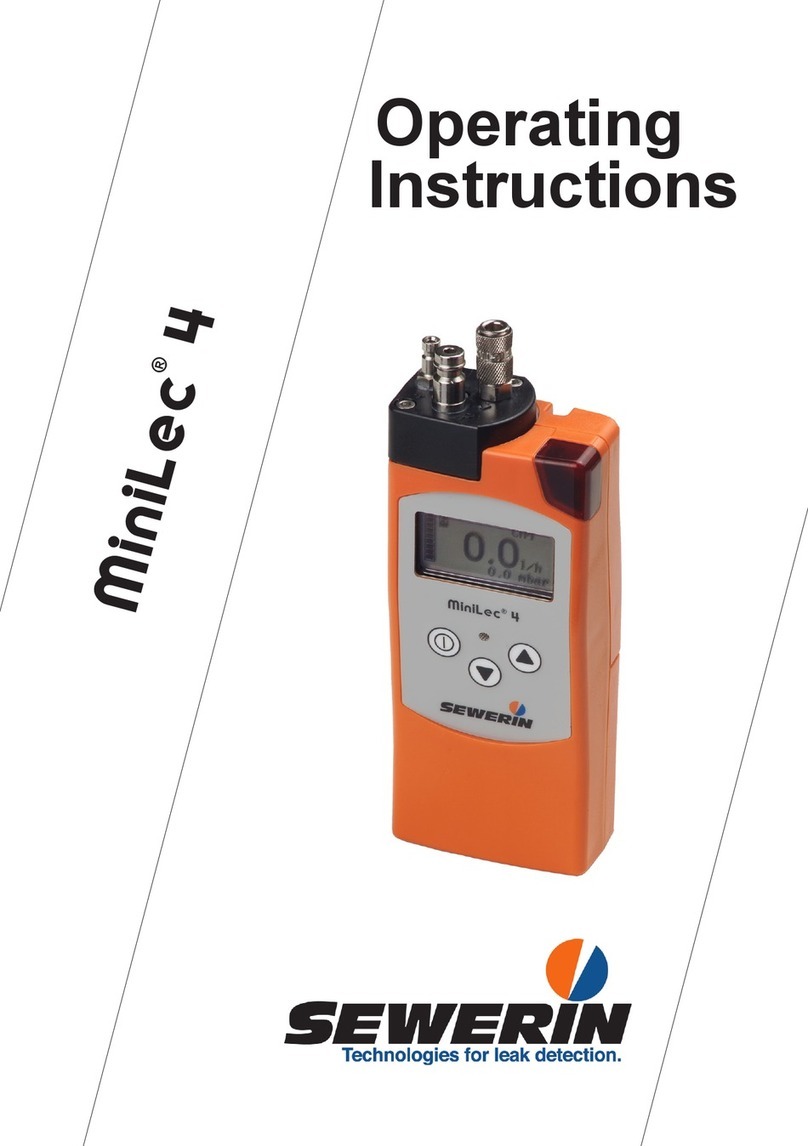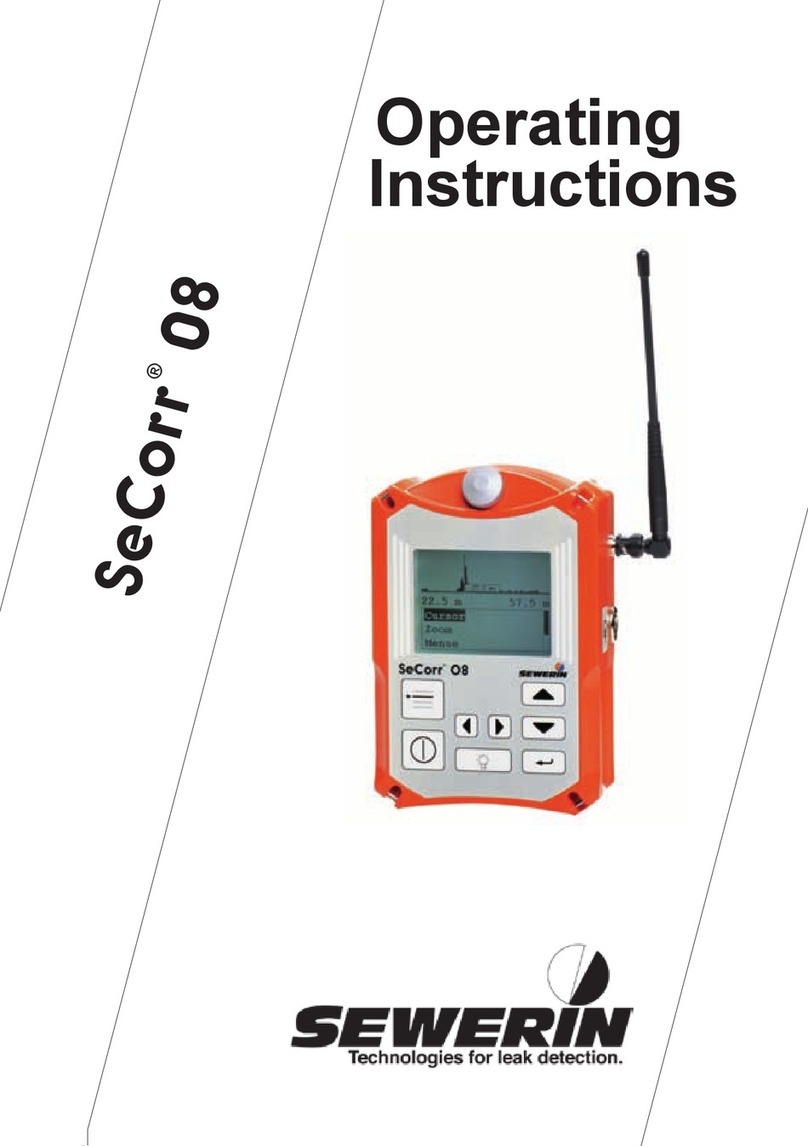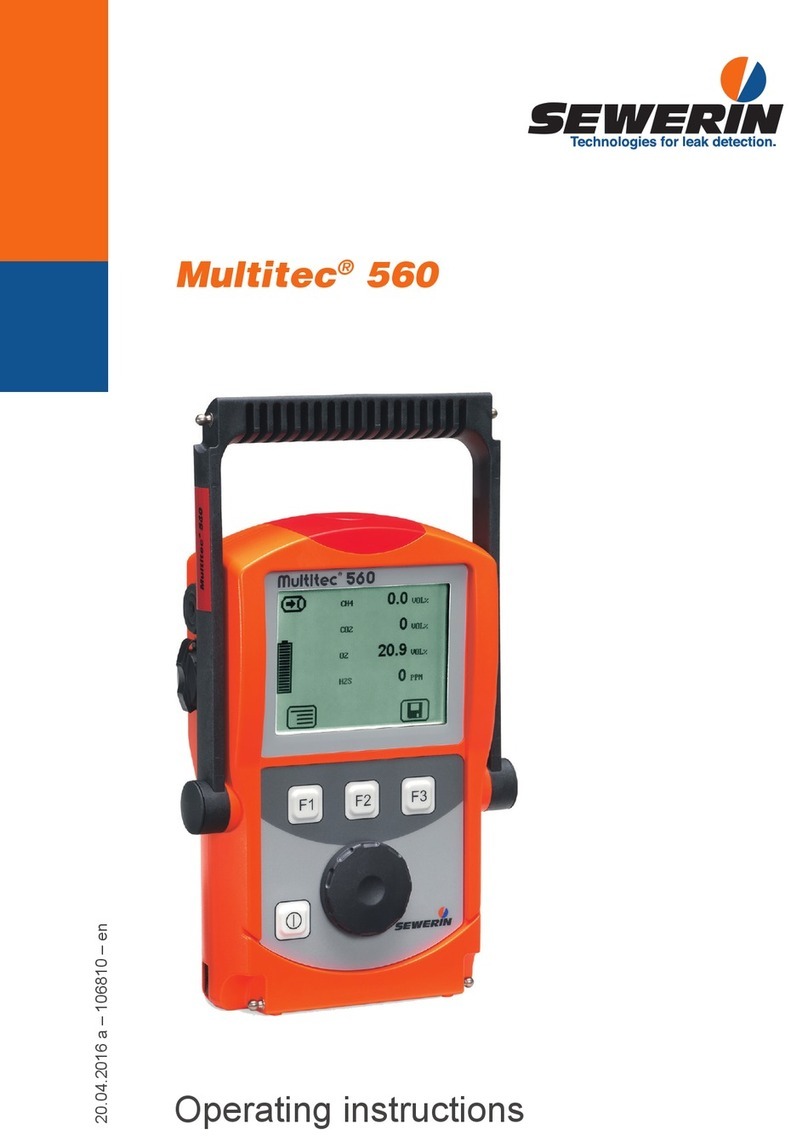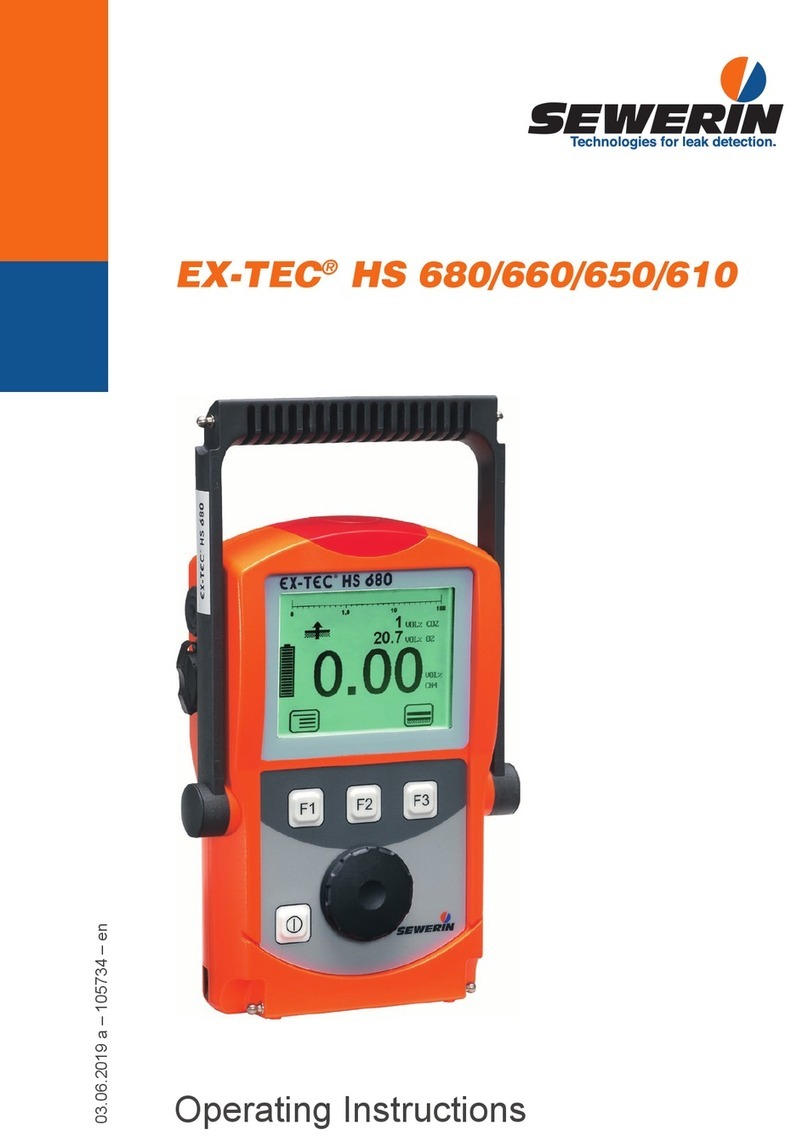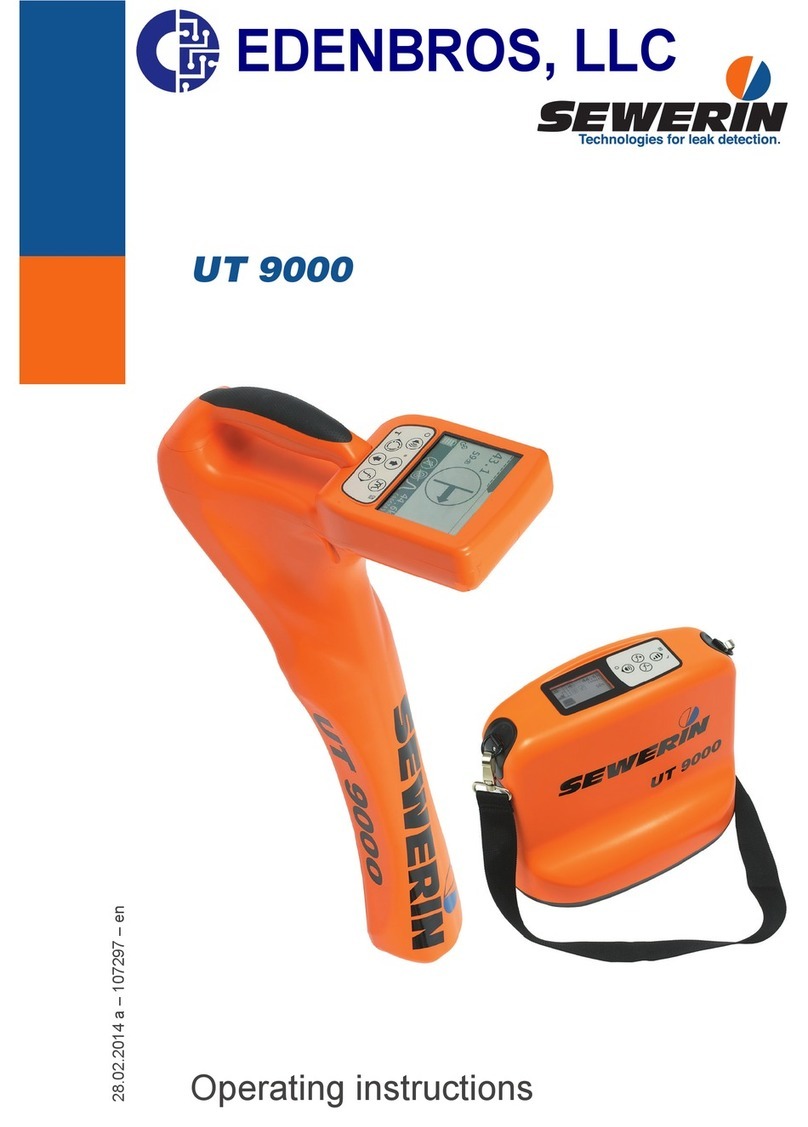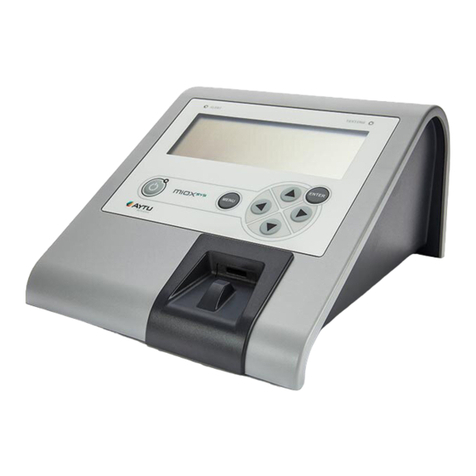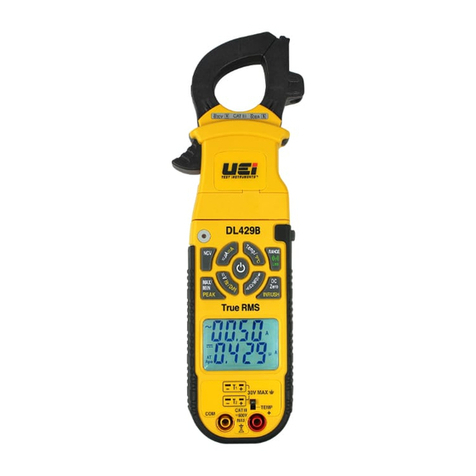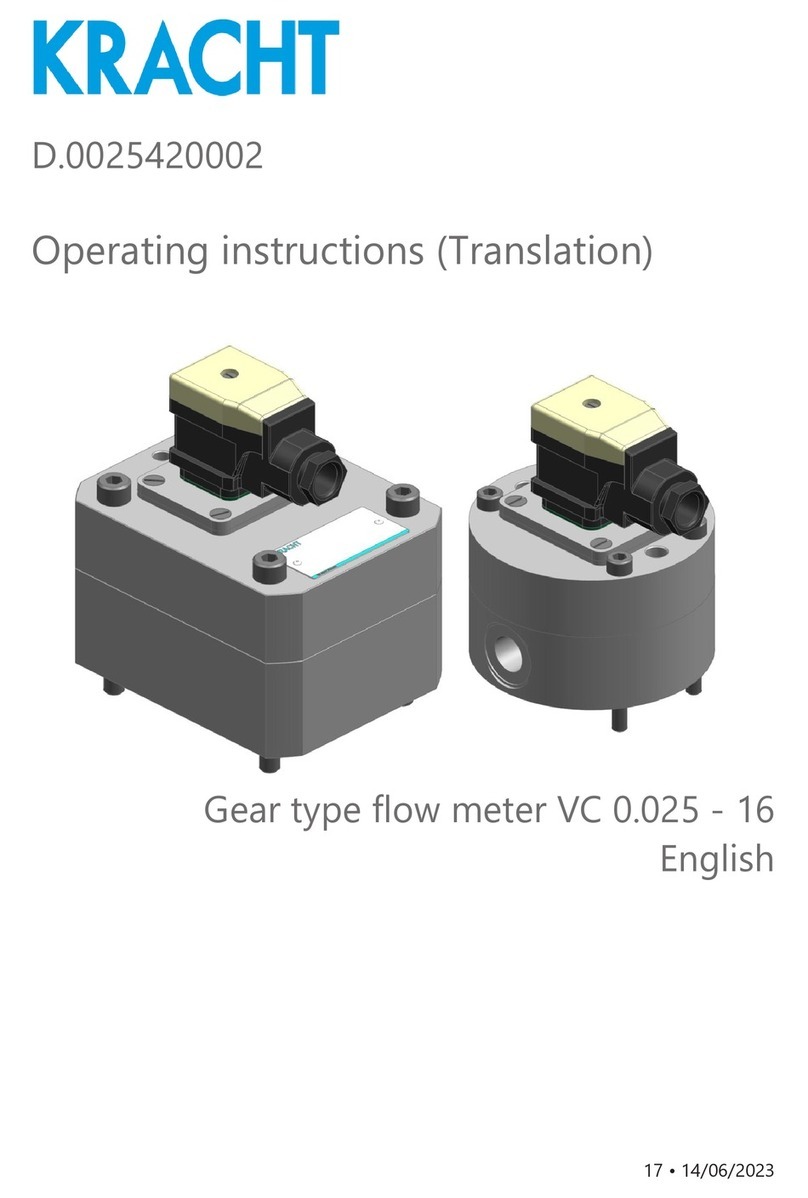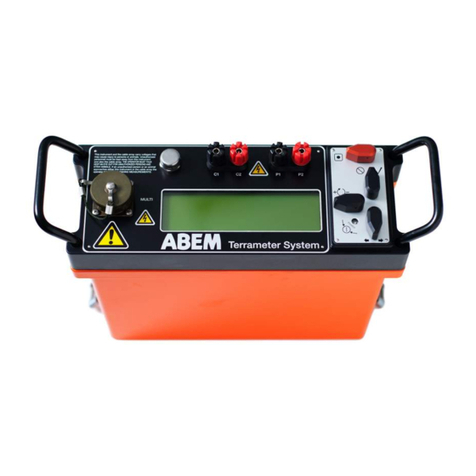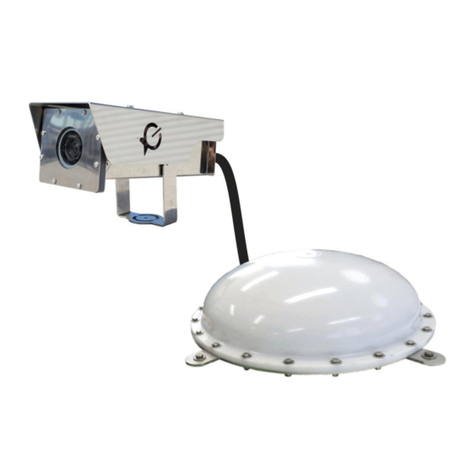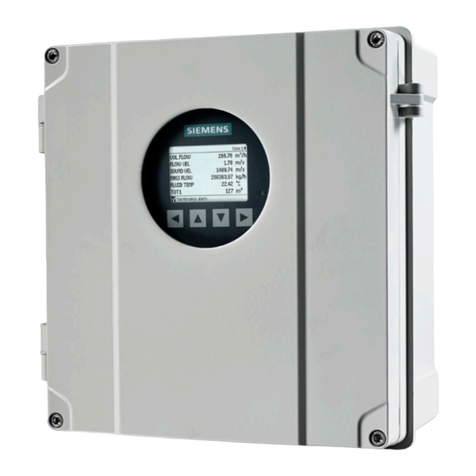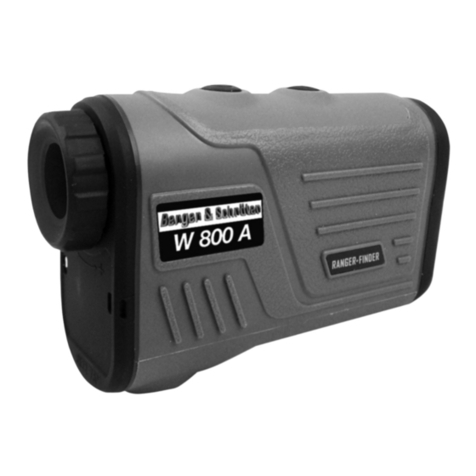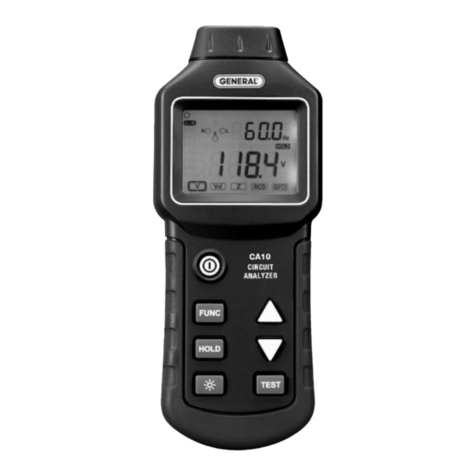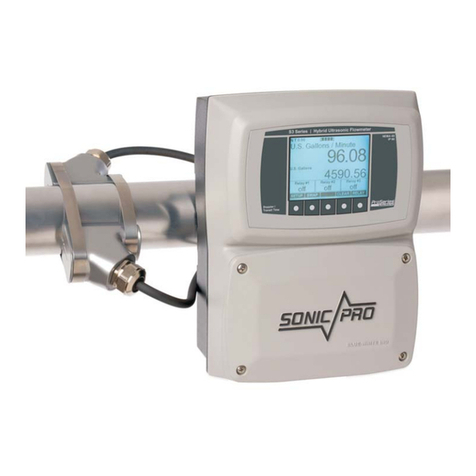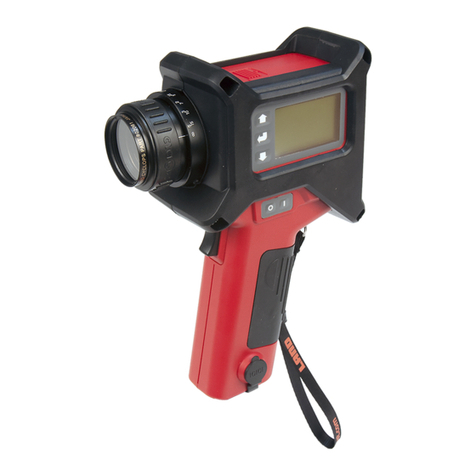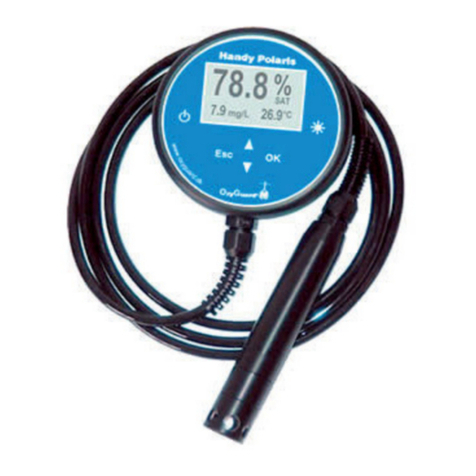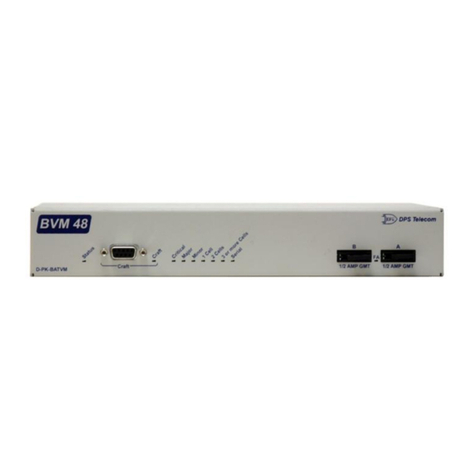sewerin Multitec 545 User manual

Multitec®545/540
Operating Instructions
15.07.2021 a – 105832 – en

Multitec®545/540
Connector
Buzzer
USB port
ON/OFF key
Connection for
power supply
Signal light
Gas input
Function keys
Jog dial
Connector
Display
Measured
value
Battery capacity
Gas measuring
symbol
Gas Unit
Current assignment of
function keys F1 – F3
Supporting bracket
Fig. 1: Multitec 540 device overview
Fig. 2: Multitec 540 display

Display symbols
General
Menu Fault
OK Perform device inspection
Esc
Cancel Tab
(jump to next input eld)
Save
Clear Information
Battery capacity Open stored comment
Open stored inspector
Applications
Interspace Gas measuring

Information about this document
The warnings and notes in this document mean the following:
ADANGER!
Risk of personal injury. Will result in serious injury or death.
AWARNING!
Risk of personal injury. Could result in serious injury or death.
ACAUTION!
Risk of personal injury. Could result in injury or pose a risk
to health.
NOTICE!
Risk of damage to property.
Note:
Tips and important information.
Numbered lists (numbers, letters) are used for:
●Instructions that must be followed in a certain order
Lists with bullet points (point, dash) are used for:
●Lists
●Instructions that only involve one step
Numbers between forward slashes /.../ refer to the referenced docu-
ments.

Contents │ I
1 General.....................................................................................1
1.1 Warranty ...................................................................................1
1.2 Purpose.....................................................................................2
1.3 Intended use .............................................................................3
1.4 General safety information ........................................................4
2 Features ...................................................................................5
2.1 Visual and audible signals.........................................................5
2.2 Sensors .....................................................................................5
2.3 Explosion protection..................................................................6
3 Operation .................................................................................7
3.1 General information on operation..............................................7
3.1.1 Keys and jog dial....................................................................7
3.1.2 Selecting/exiting menus and menu items...............................7
3.1.3 Switching the device on .........................................................8
3.1.4 Selecting/changing the application.........................................9
3.1.5 Dierences between measuring mode and settings mode ..10
3.2 Measuring mode .....................................................................10
3.2.1 Accessing the menu (measuring mode menu structure)......10
3.2.2 Zero point ............................................................................. 11
3.2.3 Interspace ............................................................................12
3.2.4 Gas measuring.....................................................................13
3.2.5 Settings ................................................................................14
3.2.6 Saving a measurement ........................................................14
3.2.7 Protocols ..............................................................................15
3.2.8 Device inspection .................................................................15
3.2.9 Device information ...............................................................16
3.3 Settings ...................................................................................16
3.3.1 Opening settings ..................................................................16
3.3.2 Settings menu structure .......................................................18
3.3.3 Adjustment ...........................................................................19
3.3.4 System .................................................................................20
3.3.5 Alarms ..................................................................................21
3.3.6 Date/time..............................................................................21
3.3.7 Memory ................................................................................21

II │ Contents
4 Power supply.........................................................................22
4.1 Suitable disposable/rechargeable battery types .....................22
4.2 Operation with rechargeable batteries ....................................23
4.2.1 Charging...............................................................................23
4.2.2 Rechargeable battery maintenance .....................................24
4.3 Battery alarm...........................................................................25
4.4 Replacing disposable/rechargeable batteries .........................25
5 Maintenance ..........................................................................27
5.1 Device inspection ....................................................................27
5.1.1 General information on the device inspection ......................27
5.1.1.1 Scope................................................................................27
5.1.1.2 Frequency .........................................................................27
5.1.1.3 Documentation..................................................................27
5.1.1.4 Integrated device inspection .............................................28
5.1.1.5 Order.................................................................................29
5.1.1.6 Test gases for the device inspection .................................29
5.1.2 Performing the device inspection .........................................30
5.1.2.1 Accessing the device inspection .......................................30
5.1.2.2 Concluding the device inspection......................................31
5.1.3 Testing the general status ....................................................32
5.1.3.1 Housing.............................................................................32
5.1.3.2 Signals ..............................................................................33
5.1.3.3 Probe.................................................................................33
5.1.3.4 Filter ..................................................................................33
5.1.3.5 Pump.................................................................................33
5.1.4 Testing indication accuracy with supply of fresh air .............34
5.1.5 Testing indication accuracy with supply of test gas..............34
5.2 Adjustment ..............................................................................36
5.2.1 Scope ...................................................................................36
5.2.2 Test gases for the adjustment ..............................................37
5.2.3 Special features of adjustment with gas mixture..................38
5.2.4 Preparation...........................................................................39
5.2.5 Performing the adjustment ...................................................39
5.2.5.1 Adjusting the zero point.....................................................39
5.2.5.2 Adjusting the sensitivity.....................................................40
5.2.6 Performing an oxygen adjustment .......................................41
5.2.6.1 Adjusting the zero point for oxygen...................................41
5.2.6.2 Adjusting the sensitivity for oxygen...................................42
5.3 Servicing .................................................................................43

Contents │ III
6 Faults......................................................................................44
7 Appendix................................................................................45
7.1 Specications and permitted operating conditions..................45
7.2 Alarm.......................................................................................46
7.3 Limit values for the device inspection .....................................46
7.4 Memory capacity .....................................................................47
7.5 Sensors ...................................................................................47
7.5.1 Infrared sensors (IR) ............................................................47
7.5.1.1 Methane CH4 (interspace).................................................47
7.5.1.2 Methane CH4 (gas measuring)..........................................47
7.5.1.3 Carbon dioxide CO2.........................................................48
7.5.2 Electrochemical sensors (EC)..............................................48
7.5.2.1 Oxygen O2........................................................................48
7.5.2.2 Hydrogen sulphide H2S.....................................................48
7.5.2.3 Carbon monoxide CO .......................................................49
7.6 Technical information ..............................................................49
7.6.1 Identication sticker (back of device) ...................................49
7.6.2 Cleaning ...............................................................................50
7.6.3 Electrostatic charge..............................................................50
7.7 Accessories and consumables................................................51
7.8 Declaration of conformity ........................................................52
7.9 Advice on disposal ..................................................................53
7.10 Terminology and abbreviations ...............................................53
7.11 Referenced documents ...........................................................54
8 Index.......................................................................................55

1 General │ 1
1 General
1.1 Warranty
The following instructions must be complied with in order for any
warranty to be applicable regarding functionality and safe opera-
tion of this equipment. This product must only be commissioned
by qualied professionals who are familiar with the legal require-
ments (Germany: DVGW).
●Read these operating instructions prior to operating the prod-
uct.
●Use the product only as intended.
●Repairs and maintenance must only be carried out by special-
ist technicians or other suitably trained personnel. Only spare
parts approved by Hermann Sewerin GmbH may be used
when performing repairs.
●Use only suitable battery types, otherwise the device will not
be explosion-proof.
● Changes or modications to this product may only be carried
out with the approval of Hermann Sewerin GmbH.
●
Use only Hermann Sewerin GmbH accessories for the product.
Hermann Sewerin GmbH shall not be liable for damages result-
ing from the non-observance of this information. The warranty
conditions of the General Terms and Conditions (AGB) of Her-
mann Sewerin GmbH are not aected by this information.
In addition to the warnings and other information in these Operat-
ing Instructions, always observe the generally applicable safety
and accident prevention regulations.
The manufacturer reserves the right to make technical changes.

2 │ 1 General
1.2 Purpose
The Multitec 545 and the 540 version are gas measuring de-
vices for monitoring gas mixtures that are formed in biological
processes (biogas, landll gas). They measure the concentration
of several gases in the gas mixture simultaneously. The devices
are ideal for use in waste disposal sites, sewage plants and bi-
ogas plants.
In addition, the devices can be used to monitor the interspace
of membrane roofs of biogas plant fermenters. When used in
this way, the gas concentration is measured in the support air
between the inner and outer membrane.
The devices are tted with infrared sensors for measuring meth-
ane CH4and carbon dioxide CO2as standard. The Multitec 545
also features an electrochemical sensor for hydrogen sulphide
H2S (5000 ppm) as standard. Both models can be tted with ad-
ditional electrochemical sensors.
Note:
These operating instructions describe the Multitec 545 with all
additional equipment (rmware version 1.XXX). All descriptions
refer to the device as delivered (factory settings) and apply to
both device versions. The manufacturer reserves the right to
make changes.

1 General │ 3
1.3 Intended use
This device is intended for professional residential and commer-
cial use including small rms and commercial operations. The ap-
propriate specialist knowledge is required to operate the device.
The device may be used to measure the following gases (de-
pending on the sensors tted).
●Methane CH4
●Carbon dioxide CO2
●Carbon monoxide CO
●Oxygen O2
●Hydrogen sulphide H2S
If the device is used in closed spaces these must be well ven-
tilated.
It should not be used for:
● Warning against ammable and toxic gases (operator protec-
tion)
●Monitoring liquids
The device can be used up to a temperature of 40 ºC. How-
ever, high temperatures reduce the lifetime of the sensors and
rechargeable batteries.
If a device with an electrochemical sensor is exposed to con-
centrations above the measuring range limit, this can reduce the
lifetime of the sensor.

4 │ 1 General
1.4 General safety information
●
The Multitec545 or 540 is a gas measuring device as opposed
to a gas warning instrument. It does not, therefore, warn of
dangerous toxic and explosive gas concentrations or lack of
oxygen. If you suspect dangerous gas concentrations, always
take along a gas warning device too.
●Observe the relevant safety regulations when working at agri-
cultural biogas plants /1/.
●
When working in closed spaces, these must be well ventilated.
SEWERIN recommends: For measurements in closed spaces,
attach the gas outlet adapter to the device to reduce the risk
of high concentrations at H2S. The gas outlet adapter can be
purchased as an accessory.
●The device has been tested to ensure that it is explosion-proof
in accordance with European standards (CENELEC).
●Do not use this device in oxygen-enriched atmospheres, oth-
erwise it will not be explosion-proof.
● Only probe hoses with a hydrophobic lter may be used.
Exception:
If the probe has a built-in hydrophobic lter, the hose does not
require any other lters.
●Devices may only be tested with test gases in well ventilated
areas or outdoors. Test gases must be handled in a profes-
sional manner.
●Always perform a device inspection (section 5.1) after the de-
vice has suered an impact (for example, if dropped acciden-
tally).
●The device complies with the limits of the EMC directive. Al-
ways observe the information in the manuals of (mobile) ra-
dio equipment when using the device close to (mobile) radio
equipment.
Note:
Follow the advice regarding explosion protection (section 2.3).

2 Features │ 5
2 Features
The device comes in two models:
Multitec 545
MultiTec 540
2.1 Visual and audible signals
The device features two alarms:
● Signal light on top of device (visual signal)
● Buzzer on side of device (audible signal)
The signals indicate faults (section 6). The device also emits
signals when it is switched on and o.
2.2 Sensors
The device features two types of sensor:
● Infrared sensor (IR)
● Electrochemical sensor (EC)
Gas Measuring range Sensors Features
CH40.0 – 100% vol. IR ×
CO20 – 100% vol. IR ×
CO 0 – 500 ppm EC ○
H2S 0 – 5000 ppm
(Multitec 545 only)
EC ×
0 – 2000 ppm
(Multitec 540only)
EC ○
O20 – 25.0% vol. EC ○
× standard, ○ optional

6 │ 2 Features
NOTICE! Damage caused by leaking sensors
Electrochemical sensors that are faulty or whose expected ser-
vice life is exceeded can leak. The leaking substance can cause
permanent damage to the device.
Faulty sensors can be identied, for example, by the fact that the
corresponding adjustment is no longer possible.
The installation date of the sensor and the expected lifetime can
be found in the Device information.
●
Always arrange for SEWERIN Service to replace faulty or leaky
sensors immediately.
2.3 Explosion protection
The device is assigned to the following explosion-proof groups:
Explosion-proof
group
For the following
atmospheres
When using
II2G Ex d e ib IIB T4 Gb
Methane CH4
Propane C3H8
Butane C4H10
Hydrogen sulphide H2S
Device
without
carrying bag
TG8
II2G Ex d e ib IIC T4 Gb
Methane CH4
Propane C3H8
Butane C4H10
Hydrogen sulphide H2S
Hydrogen H2
Device with
carrying bag
TG8
EC type-examination certicate: TÜV 07 ATEX 553353 X
ADANGER! Risk of explosion from sparks
●Only ever open the battery compartment outside of ex-
plosive areas.
●
Only ever charge the device outside of explosive areas.
●Only use the USB port outside of explosive areas.
●Use only suitable battery types.

3 Operation │ 7
3 Operation
3.1 General information on operation
3.1.1 Keys and jog dial
The ON/OFF key is the only control on the device that does not
change its function.
When switched on, the device is operated using the jog dial and
function keys to navigate the display.
Control Action Function
ON/OFF key Press – Switches the device on
– Switches the device o
Function keys
F1, F2, F3
Press – Variable
– As indicated on the display at the
bottom of the screen
– Function keys may also have no
function assigned in some cases
Jog dial Turn – Selects functions, settings, meas-
urement data, etc.
– Modies values
Press – Opens the next program level
(e.g. menu item, function, meas-
urement data, selectable values)
– Accept values
3.1.2 Selecting/exiting menus and menu items
Functions and settings etc. are selected via the main menu (for
short: Menu). This menu has submenus and menu items. Refer
to section 3.2.1 for information on accessing the main menu.
Selecting submenus/menu items
Submenus and menu items are selected and opened using the
jog dial and/or the function keys.
In measuring mode the name of the selected application is in-
dicated by the symbol at the top left of the display. You can nd

8 │ 3 Operation
detailed information on how to select or switch applications in
section 3.1.4.
Exiting menus/menu items
There are generally two ways to exit open menus/menu items
and return to the next level up:
●Press Esc
●Select Exit from the menu
3.1.3 Switching the device on
Note:
Always switch the device on with fresh air.
Each switch-on process is linked to activation of the buzzer, sig-
nal light and display. This allows the user to check the following
device functions:
Buzzer: Is the audible signal working?
Signal light: Is the visual signal working?
Display: Can incorrect pixels be seen in the inverse display?
●Press the ON/OFF key. The device switches on.
The start screen appears on the display.
Display:
– Device type: Multitec 540
– User:
Frank Smith
City Council
Leakage Delivery
– Firmware version: V1.400
– Date and time
– Battery capacity
Fig. 3: Start screen

3 Operation │ 9
An overview of the gases that can be detected will then ap-
pear briey.
Gas measuring
CH4 0.0..100 VOL%
CO2 0....100 VOL%
O2 0...25.0 VOL%
H2S 0...2000 PPM
CO 0... 500 PPM
Display:
– Symbol: Gas measuring
– Detectable gases
– Measurement ranges
– Battery capacity
Fig. 4: Overview of detectable gases
The device switches to measuring mode (Gas measuring ap-
plication).
VOL%
VOL%
VOL%
PPM
PPM
0.0
0
20.9
0
0
CH4
CO2
O2
H2S
CO
Display:
– Current readings: zero when
device is switched on with
fresh air
Fig. 5: Measuring mode - Gas measuring application
Wait until the measurement values stop ashing. The device
is then ready for use.
3.1.4 Selecting/changing the application
Note:
You may only switch applications when the device is drawing in
fresh air.
The current application is indicated by the symbol at the top left
of the display.
●
Press Menu. Select the menu item for the application you want
to use.

10 │ 3 Operation
3.1.5 Dierences between measuring mode and settings mode
The device is operated in two modes:
●Measuring mode (section 3.2)
Measurements are taken in measuring mode. All functions
needed to take readings can be accessed from one menu.
●Settings (section 3.3)
The device settings can be changed in settings mode. Infor-
mation about the device can also be retrieved. Measurements
cannot be taken in settings mode.
Settings are accessed via the menu in measuring mode. The
settings are access-protected by a PIN code.
3.2 Measuring mode
When switched on the device is in measuring mode (sec-
tion 3.1.3). In measuring mode, the current readings are always
displayed (Fig. 5).
3.2.1 Accessing the menu (measuring mode menu structure)
In measuring mode F1 can be used to access the Menu.
Zero point
Interspace
Gas measuring
Settings
Save measurement
Protocol
Device inspection
Device information
Exit
Fig. 6: Menu with submenus (menu items)
Protocols is only visible in the menu if at least one protocol is
saved.
Device inspection only appears in the menu when the integrat-
ed device inspection is switched on (section 5.1.1.4).

3 Operation │ 11
3.2.2 Zero point
The zero point only has to be set manually if the displayed fresh
air measurement is not zero after the end of the warm-up period.
Gas Content in fresh air Correct zero point on device
O220.9 % vol. 20.9 % vol.
CO20.04 % vol. 0 % vol.
CH40 % vol. 0 ppm or 0.0 % vol.
H2S 0 ppm 0 ppm
CO 0 ppm 0 ppm
The manual zero point setting is not saved. The zero point can
be corrected by adjustment as often as zero point deviations oc-
cur (section 5.2).
Requirements for correct setting of the zero point
●Device has been switched on with fresh air.
●Device continues to draw in fresh air.
Setting zero point (manual zero point setting)
1. Press Menu.
2. Select Zero point from the menu. The values are automati-
cally adjusted. The device returns again to measuring mode.
In the Interspace application, you can also access the Set zero
point function using the corresponding symbol.

12 │ 3 Operation
3.2.3 Interspace
The measuring mode can be changed to the Interspace applica-
tion via this menu item.
If the device is already in the Interspace application, you can
access an overview of detectable gases via this menu item. The
device automatically returns to measuring mode.
Area of use
– Monitoring the interspace of gas membranes for leaks
– Leak tightness of fermenters, e.g. at greased cable outlets
Symbol
Measuring range
Infrared sensor CH40 ppm to 1.00 % vol.
Measurement data display
– Figure, e.g.
0 ppm CH4
– Bar graph with quasi-logarith-
mic scale
Fig. 7: Interspace measuring mode

3 Operation │ 13
3.2.4 Gas measuring
The measuring mode can be changed to the Gas measuring
application via this menu item.
If the device is already in the Gas measuring application, you
can access an overview of detectable gases via this menu item.
The device automatically returns to measuring mode.
Area of use
– Measuring the composition of biogas
– Proof of absence of gas in gas pipes
Symbol
Measuring range
Infrared sensor
(Methane CH4)
0.0 to 100 % vol.
Infrared sensor
(Carbon dioxide CO2)
0 to 100 % vol.
Electrochemical sensor
(Oxygen O2)
0.0 to 25.0 % vol.
Electrochemical sensor
(Hydrogen sulphide H2S)
Multitec 545: 0 to 5000 ppm
Multitec 540: 0 to 2000 ppm
Electrochemical sensor
(Carbon monoxide CO)
0 to 500 ppm
Measurement data display
VOL%
VOL%
VOL%
PPM
PPM
0.0
0
20.9
0
0
CH4
CO2
O2
H2S
CO
– Figure, e.g.
0.0 % vol. CH4
0 % vol. CO2
20.9 % vol. O2
0 ppm H2S
0 ppm CO
Fig. 8: Gas measuring mode
This manual suits for next models
1
Table of contents
Other sewerin Measuring Instrument manuals
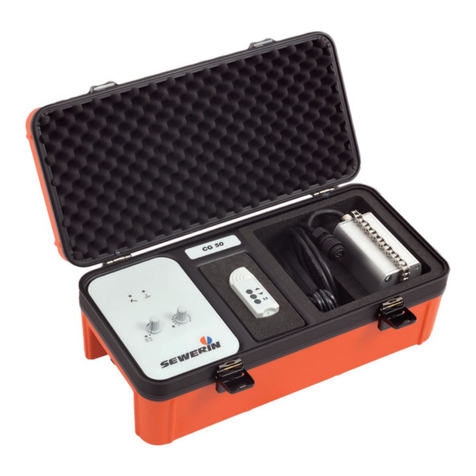
sewerin
sewerin COMBIPHON User manual
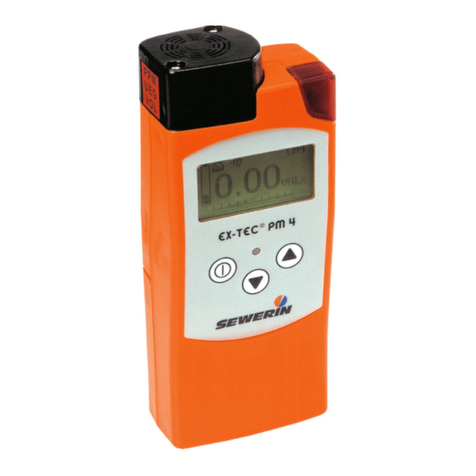
sewerin
sewerin EX-TEC PM 4 User manual
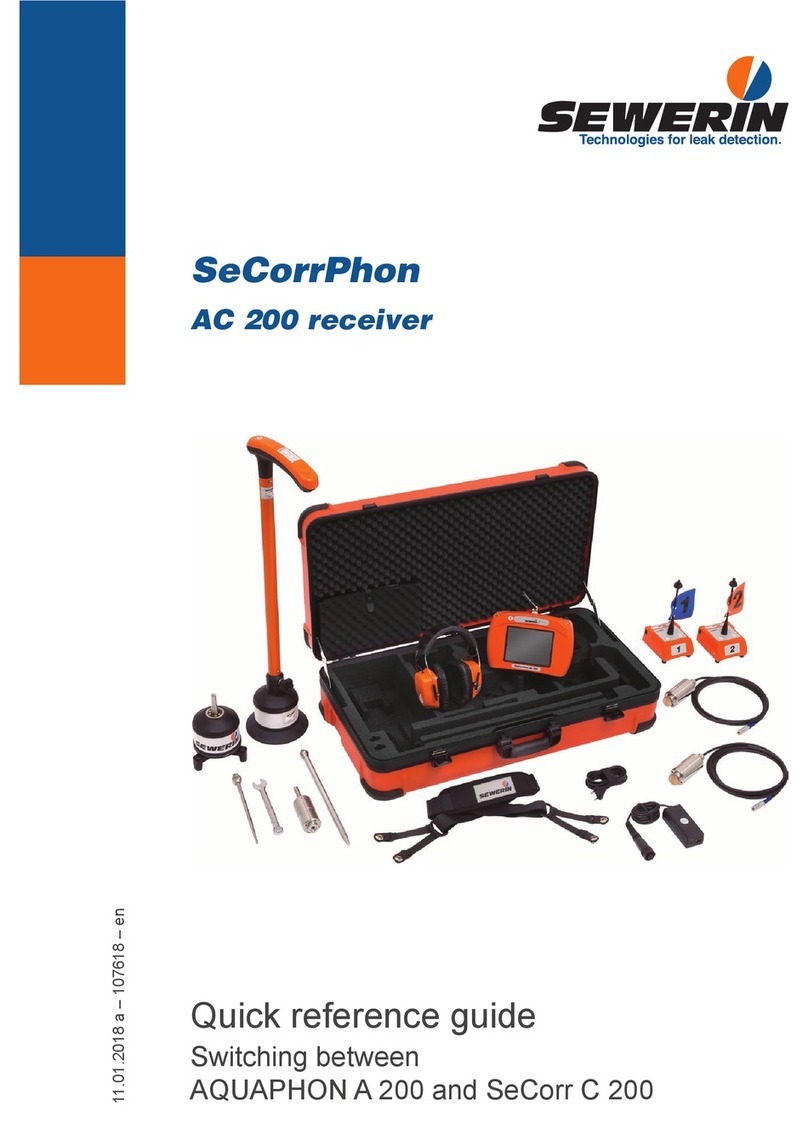
sewerin
sewerin SeCorrPhon AC 200 User manual
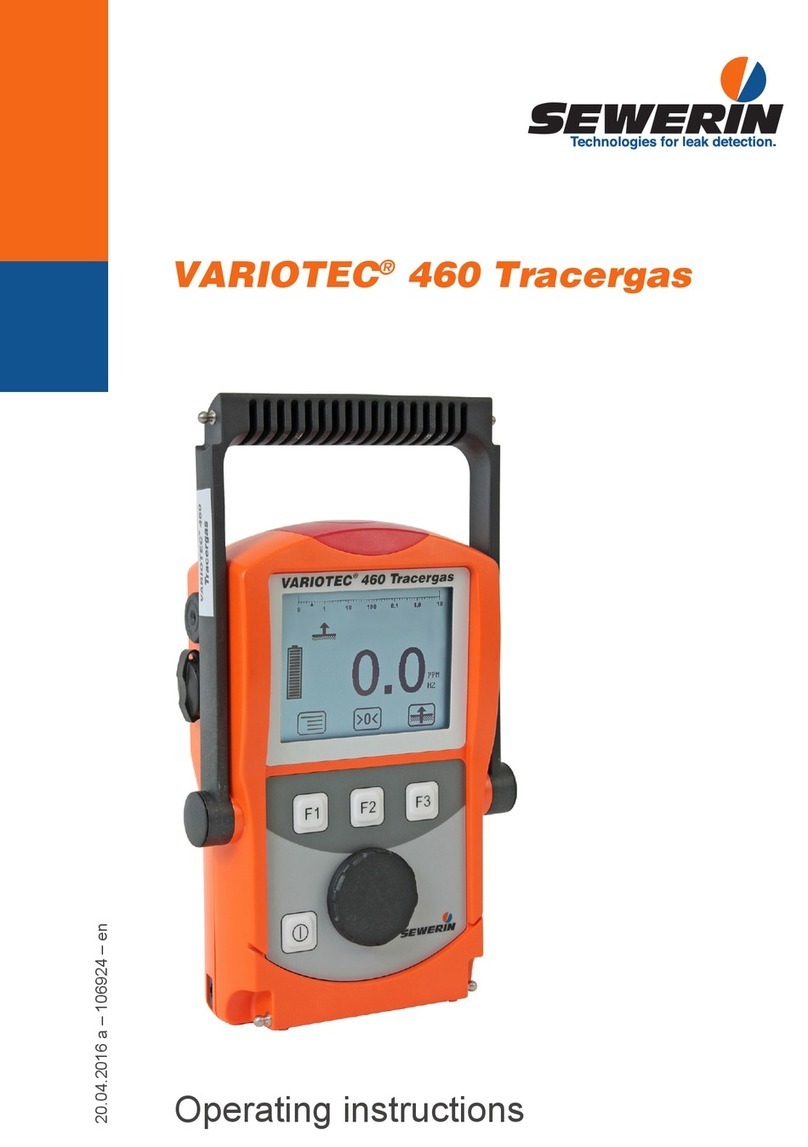
sewerin
sewerin VARIOTEC 460 Tracergas User manual
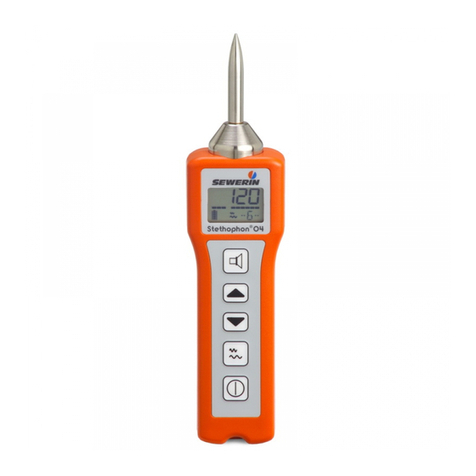
sewerin
sewerin Stethophon 04 User manual
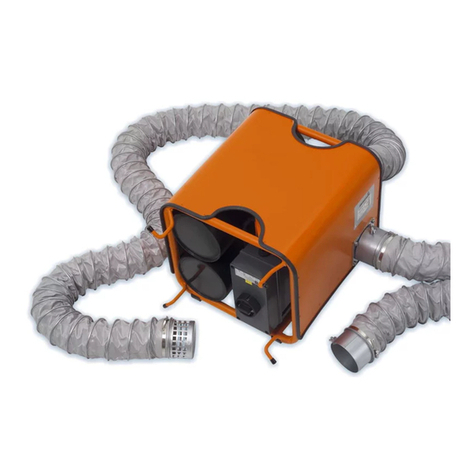
sewerin
sewerin FLIS-EX User manual
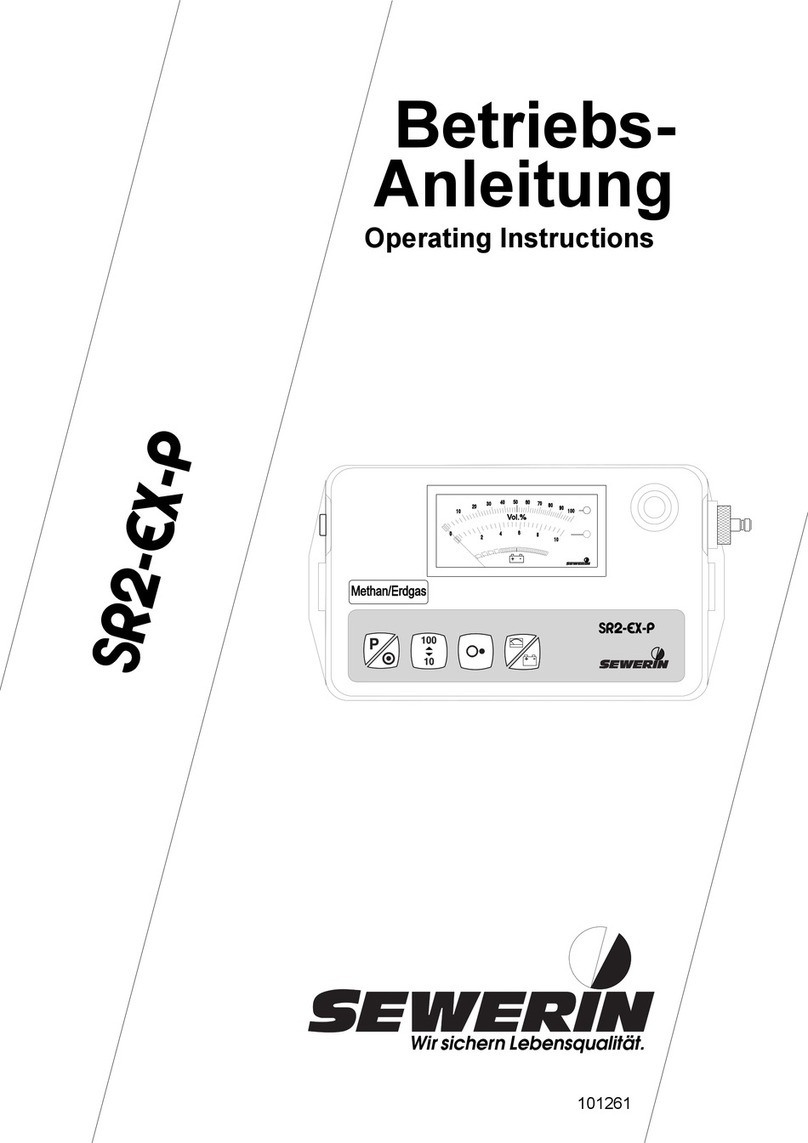
sewerin
sewerin SR2-EX-P User manual
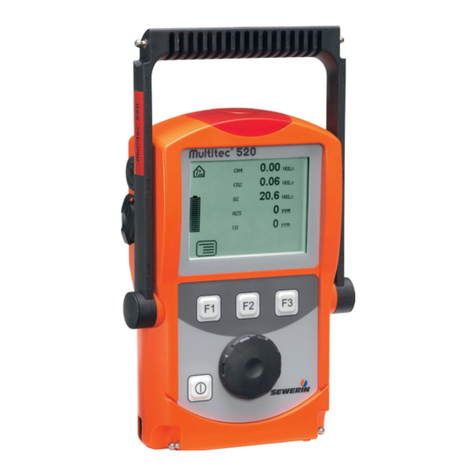
sewerin
sewerin Multitec 520 User manual
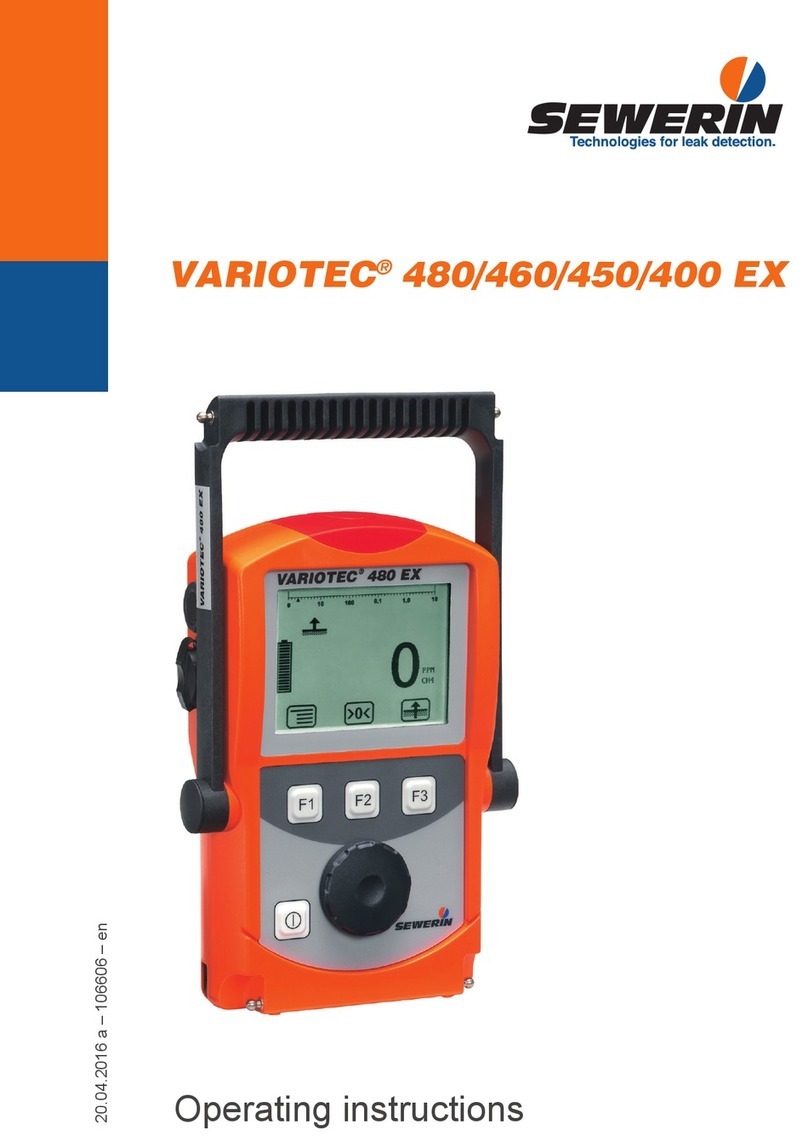
sewerin
sewerin VARIOTEC 480 EX User manual
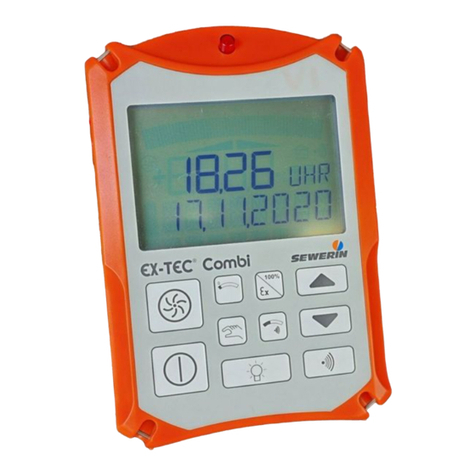
sewerin
sewerin EX-TEC Combi User manual

